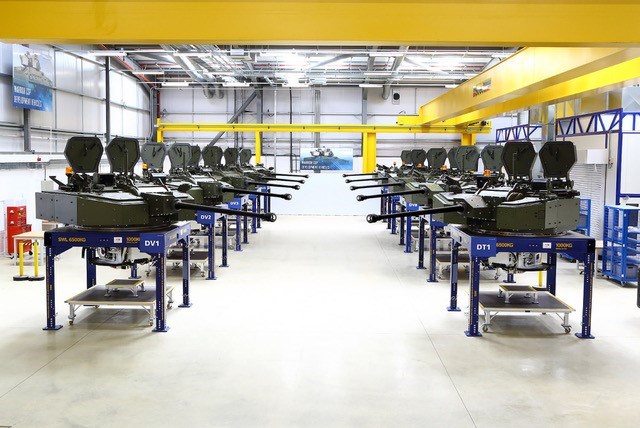When people mention the words Lockheed Martin, the first things that usually spring to mind are the ageless C-130 Hercules transport aircraft and the new F-35 Lightning II fighter. But the US giant’s UK operations include technology that will come as a surprise to many as Peter Ruddock, the company’s UK chief executive, explained to Alan Dron.
Large, exotically shaped turbine blades are something you would expect aircraft manufacturer Lockheed Martin to know a lot about. What you might not expect is for them to be operating in water, rather than air.

The Pentland Firth, the wild stretch of water that separates the northern coast of Scotland from the Orkneys, is the site of a groundbreaking scheme designed to extract energy from the tidal races that pass through the firth at around 6kts.
That makes the channel one of the best potential sites in the world for tidal power and it is where Lockheed Martin UK is involved in a project that could have major benefits for the future of the country’s power generation.
“The Pentland Firth has enough tidal stream resource to produce sufficient electricity for half of Scotland’s needs,” explained Peter Ruddock, Lockheed Martin UK’s chief executive.
Harnessing potential
That is a staggering potential output, but the key word is ‘potential’. First, the Lockheed Martin and Atlantis Resources team have to tame and harness the huge forces that act on any underwater structure in the firth.
“It’s a very austere environment,” said Ruddock, who took on his present role in 2015 after a career in the RAF that saw him ascend to Air Marshal and act, inter alia, as commander of the UK air component for both Afghanistan and Iraq.
The technical challenge of designing and installing the underwater turbines has two aspects: the problem of making the blades change their configuration to follow the tides during the day; and the cost of building in that capability and the resilience of coping with the underwater stresses.
“To make a turbine that’s efficient and reliable in that environment, you have to add quite a lot of engineering. It’s a very good design, the challenge is really in getting it to a price point that makes it economically viable.”
The first two turbines in a pilot scheme were installed earlier this year. Although still early days, Ruddock said: “Initial feedback has been very positive.”
In the post
Lockheed Martin’s UK activities cover other unlikely-sounding areas, such as sorting 40 million postal items a day – thanks to the company’s experience in optical character reading and the ability of its postal sorting machines to ‘learn’ to decipher poorly executed handwriting.
But close to 90% of its business is in the defence and aerospace sector. Possibly the most significant programme with which it is associated is the F-35 Lightning II, with the first aircraft for the Royal Air Force due to arrive at RAF Marham, Norfolk, next year.
Marham, where Lockheed Martin UK and its partners BAE Systems and Balfour Beatty are building a range of maintenance, training and logistics facilities to house the ultra-sophisticated fifth-generation combat aircraft, “is absolutely critical”, said Ruddock.
“The Ministry of Defence is investing a significant amount of money to upgrade the base for the F-35. I was recently up there for the topping-out ceremony for the main facility and we’re on track to deliver [the programme].”
There are three categories of personnel with whom Lockheed Martin UK is involved at Marham: the maintenance personnel who will work on the actual aircraft, those who will train them and those who will manage the logistical support for the aircraft and its supporting facilities.
Among the latter is the autonomic logistics information system (ALIS). A modern combat aircraft is an amalgam of tens of thousands of components. ALIS treats each aircraft as an entity and tracks every component on it.
An unusual model
In some ways, the military is only catching up with technology that is already well established in the civil airliner sector. ALIS will flag up any component that fails during a flight but will also be used to undertake predictive maintenance, calculating when a component is deemed to be reaching the end of its life and allowing it to be switched out before a failure occurs.
The precise arrival dates of the F-35 in the UK in 2018 are down to the MoD, said Ruddock, although indications were that they should start to arrive from the middle of the year. By the end of 2018, the lead squadron, 617, is required to have attained initial operational capability (IOC) (land), with a maritime IOC due to follow around two years later.
“The unusual thing is that the squadron is working up at Marine Corps Air Station Beaufort, South Carolina. They’ll come across as a fully formed unit and do the final part of their preparation here in the UK,” said Ruddock.
“It’s quite an unusual model, but very effective, because we get the benefit of the US Marine Corps’ experience, so we’re not having to trailblaze ourselves. That has allowed us more time to mature the solution in the UK. It has allowed us to reduce risk and comes with a very high probability of meeting the various milestones.”
Also bulking large in Lockheed Martin UK’s current portfolio is the provision of new turrets for the Army’s existing Warrior armoured fighting vehicles (AFVs) and for the forthcoming Scout SV/Ajax that is due to replace the 1970s-vintage Combat Vehicle Reconnaissance (Tracked) (CVR(T)) family of equipment, such as the Scorpion armoured reconnaissance vehicle.

The company invested around £100 million of its own funds in its factory at Ampthill, Bedfordshire, to make it ready for production of the new turret, which is fitted with a UK Government-supplied 40mm cannon, the CT40.
“At Ampthill we’ve got, I would say, a world-class turret facility,” said Ruddock. “The new turret is all about fightability, survivability and lethality. We addressed a lot of the legacy-inherent challenges in the original design.
The new turret is much more ergonomic and comfortable to fight in. The CT40 has undergone a number of changes over time and we’ve been very agile in adapting those. We’ve delivered the first turrets to General Dynamics [manufacturers of Scout SV/Ajax] and are on schedule.”
The original plan was initially to produce the turrets to modernise the Army’s existing AFV fleet under the Warrior capability sustainment programme, part of which will see the vehicle’s current turret mounting, an unstabilised 30mm RARDEN cannon, replaced by the new mounting for the larger-calibre, stabilised CT40 weapon. However, plans have changed and the Scout SV/Ajax will now be first to mount it.
Other major defence projects in which the company is leading or heavily involved include bringing 30 of the Royal Navy’s fleet of Agusta Westland Merlin helicopters up to HM2 standard and the Crowsnest project, under which 10 of the Merlins will be outfitted with a Thales Searchwater airborne radar system to give early warning capability to the fleet.
Modified Merlins, equipped with an updated version of the Searchwater radar, will operate from the Royal Navy’s two new Queen Elizabeth-class aircraft carriers in this role. Throughout the UK, Lockheed Martin employs some 2,000 staff (including long-term contractors) at 11 main sites, although teams of varying size can be found at around 35 locations around the country supporting customers.
“When I joined in 2011 we had around 1,500 employees,” said Ruddock. “Numbers peaked at 3,600, but we then divested in the summer of last year our IT Services to [logistics support organisation] Leidos. That reduced it by 1,600.”
Skills challenge
Lockheed Martin is aware of the skills challenges that continue to plague sectors of UK industry: “We’re very active in recruiting graduates and apprentices and the quality I’ve seen is good.” The company is a member of the ‘5% Club’, under which it makes a commitment to have 5% of its overall UK headcount from a formalised apprentice, sponsored student and/or graduate programme.
Looking to the future, Ruddock sees space as the sector with the greatest level of ambition. Lockheed Martin is traditionally reluctant to say much about its space projects as several are highly classified, but its UK operation would be keen to bid for the planned Skynet 6 constellation of communications satellites. It is also looking at the possibility of creating a space launch facility in the UK for civilian satellites.
No such sites have yet been fixed upon, but in general, “the further north you go, the more attractive it is to get satellites into the orbits you want”. Launching over water, in case of accidents, is also a preferred option, which gives the possibility of large stretches of the Scottish coast.
“We have the benefit, as well, of being able to reach back into the US and getting the benefit of the enormous industrial capability, with tremendously technical depth. It’s useful to have that very profound knowledge available and to be able to bring it into the UK.”
The biggest potential threat to the company’s ambitions, which include increasing the workforce by 2,000 through organic growth over the next few years, is the growing gap between defence ambitions and funding.
This was a major problem with the last Labour government and the painful 2010 strategic defence and security review (SDSR), which cut major capabilities and manpower from the UK armed forces, and was designed, in part, to close that gap.
The Conservative-Lib Dem coalition government of 2010-15 announced it had largely fixed the funding shortfall, but it has re-emerged in recent times, with an estimated gap of £20 billion between the government’s ambitions and available funding.
“That’s a worry, because the Ministry of Defence has been through so many efficiency programmes that finding further efficiencies of that level is going to be very challenging,” said Ruddock.
“The expectation, realistically, is that some programmes are going to come under pressure.”
The government has made considerable play of being one of the few NATO nations to meet the 2% of GDP spending target demanded by the US. However, said Ruddock, the 2% cited today was rather different from the 2% of 10-15 years ago, as today’s total included aspects of intelligence-gathering and even pensions that were not included in the figure from years past.
“In order to spend the same amount of money that you spent 10-15 years ago, you would actually have to spend considerably more today – around 2.6% of GDP.” That gives some idea, despite the government’s claims of more money being spent on defence, of how the defence budget has actually atrophied in recent years.
Another major challenge is the single source regulations (SSR) applied by government, he said. This is the system whereby the government announces the profit margin for defence companies that are sole suppliers of equipment or services.
This margin has effectively halved, from 1112% three years ago to an anticipated 6% in 2018. This is simply insufficient to make it attractive for Lockheed Martin to invest in the UK, he argued.
“A company like Lockheed Martin has opportunities to invest around the world and I’m in an internal market where I have to convince my leadership that the UK is a place in which to invest.
“Frankly, the [SSR] implementation was not well thought through. I think they used this as a rather blunt instrument to reduce spending on certain programmes.
“My challenge is to square the circle between wanting to support the customer, but also to get a fair return for our shareholders.”

